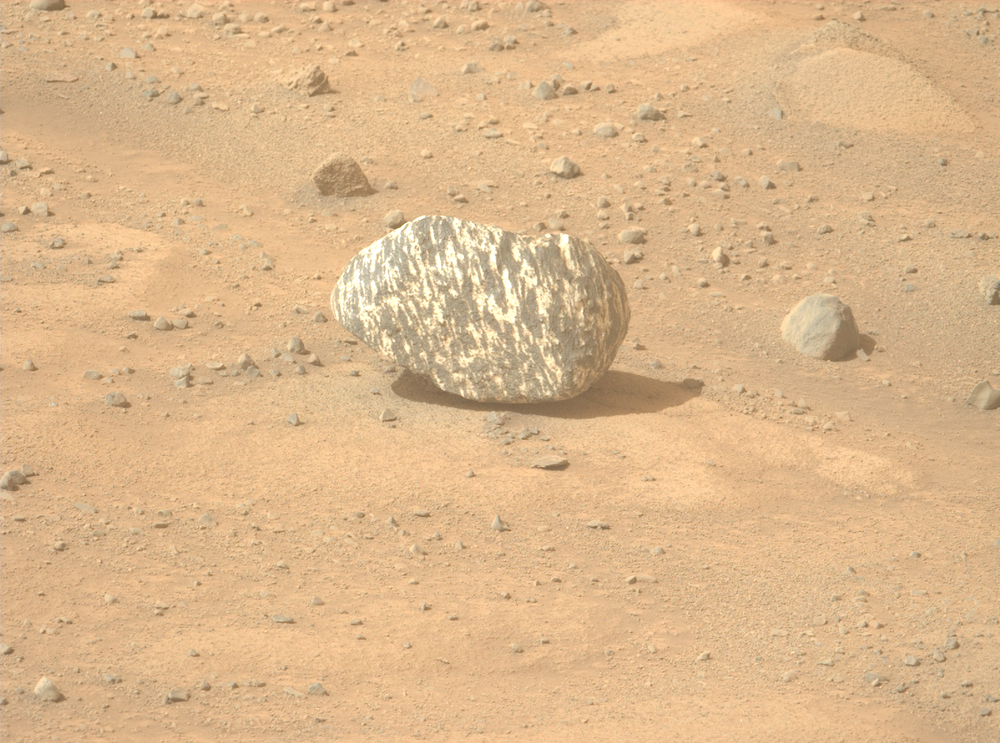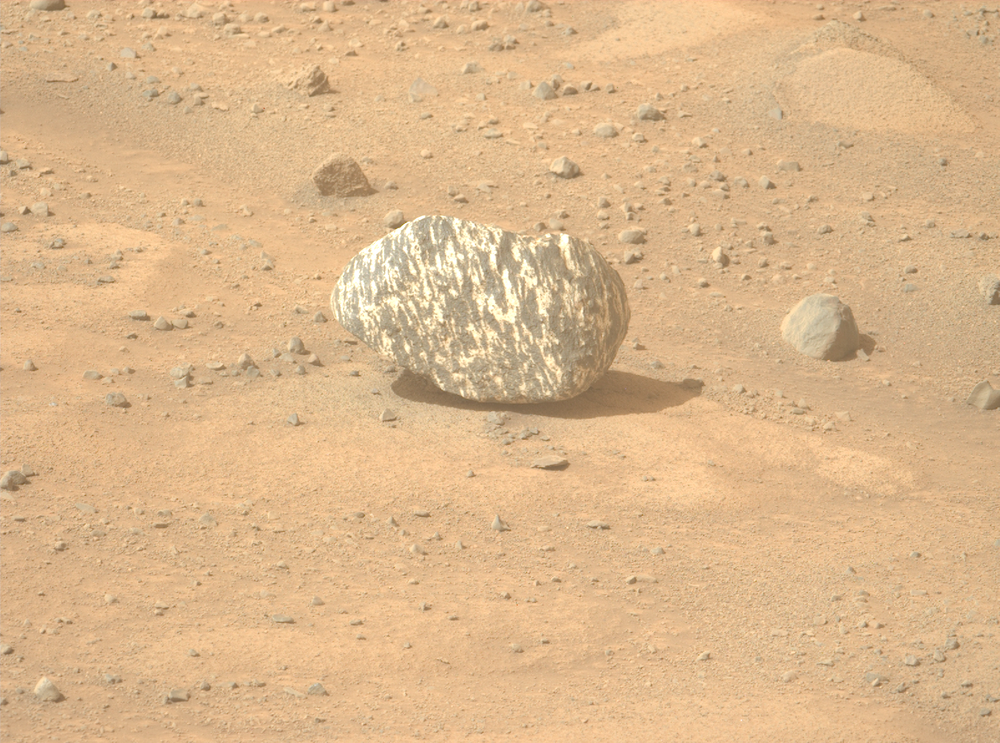NASA’s Perseverance Rover has made a striking new discovery—a black-and-white striped rock on the Martian surface dubbed “Freya Castle,” unlike anything previously seen on the Red Planet.
This unique find has sparked excitement among scientists and space enthusiasts, offering a fresh puzzle in the ongoing quest to understand Mars’ geological history.
“Team scientists and the internet alike were amazed when Perseverance spotted a black-and-white striped rock unlike any seen on Mars before,” Athanasios Klidaras, a Perseverance team member and doctoral student at Purdue University, wrote in an update published by NASA. “Is this a sign of exciting discoveries to come?”
The rock, measuring around 20 centimeters across, was spotted on September 13, 2024, during the rover’s ongoing mission in the Jezero Crater. While Mars is famous for its characteristic red hue, this new rock discovery, nicknamed “Freya Castle,” stands out in its black-and-white coloring and pattern, resembling the “tiger stripe” camouflage some militaries wear.
The unique stone was first detected using Perseverance’s Left Mastcam-Z camera while the rover was traversing the Jezero Crater’s rocky terrain. Perseverance’s Mastcam-Z system is a pair of high-tech cameras mounted on the rover’s mast, used to capture detailed images of the Martian surface.
Throughout its mission, Perseverance has uncovered a wide range of Martian rock formations. However, according to NASA’s science team, “Freya Castle” stands out as entirely unique, unlike anything previously encountered on the Red Planet.
The discovery of this patterned rock raises many intriguing questions. Striped rocks, like “Freya Castle,” are often formed on Earth through a combination of geological processes, including metamorphism and igneous activity. These patterns can emerge when contrasting minerals, such as light-colored quartz and dark-colored basalt, are layered together over time.
Metamorphic processes involving extreme heat and pressure can cause existing rock layers to recrystallize and rearrange into alternating bands of light and dark minerals.
Another possibility is igneous processes, where different lava or volcanic materials cool and solidify in layers, creating distinctive stripes. This type of formation is common in mountain ranges, such as the Alps, where tectonic activity has pushed these banded rocks to the surface.
Similar processes may be responsible for “Freya Castle” seen on Mars, though further analysis is needed to determine its exact origin.
The Perseverance team had planned to conduct a multispectral analysis of the intriguing rock using the rover’s Mastcam-Z camera. However, by the time the images of “Freya Castle” were downlinked to Earth several days later, the rover had already left the site.
NASA scientists suggest that since “Freya Castle” is a loose stone and distinct from anything in the surrounding area, it likely didn’t originate at its current location. Instead, it may have rolled downhill from higher elevations. This theory could offer new geological insights into Mars’ past, potentially shedding light on the planet’s volcanic history.


This isn’t the first time Perseverance has found curious rocks during its exploration of Mars. Earlier in 2024, the rover discovered a rock with unusual “leopard spots” in the Jezero Crater. These features sparked similar excitement due to their potential link to ancient Martian chemical processes. Scientists theorized that those spots could be evidence of past reactions that may have supported microbial life billions of years ago.
In 2021, initial analyses of rock samples collected from Jezero Crater by the Perseverance rover indicated that the Martian surface may have retained water for hundreds, possibly even thousands, of years longer than scientists had previously estimated. This discovery suggests that Mars’ watery past extended well beyond earlier projections, offering valuable new insights into the planet’s potential for habitability.
Like the leopard-spotted rock, the “Freya Castle” find fuels the ongoing search for evidence of Mars’ past habitability. While Perseverance’s primary mission is to search for signs of ancient microbial life, it also seeks to understand the planet’s geology. Each new discovery helps scientists piece together the complex history of Mars, one rock at a time.
Currently, Perseverance is navigating tricky terrain, made even more challenging by the frequent Martian dust storms. However, recent improvements in drive progress mean that the rover is now moving at a steadier pace as it explores this scientifically rich area.
Scientists are optimistic that as Perseverance continues its climb up Jezero Crater, it will encounter more instances of this “Freya Castle” rock type in its original location, allowing for more detailed studies and a deeper understanding of its origin.
Finding an intact rock source would enable scientists to conduct more comprehensive studies, possibly leading to new breakthroughs in our understanding of Mars’ geological evolution.
Ultimately, Mars holds many secrets about the formation and evolution of planets, and each new discovery by the Perseverance rover brings us closer to unlocking them.
Rocks like “Freya Castle” are valuable clues, potentially offering new insights into the volcanic and metamorphic processes that shaped Mars billions of years ago. Additionally, findings like these bolster the hope of discovering signs of ancient life on Mars, one of the central goals of the Perseverance mission.
As NASA continues to push the boundaries of planetary exploration, discoveries like this remind us that the Red Planet still holds surprises. The scientific community is eager to see what new data Perseverance will uncover next and whether it will offer further glimpses into Mars’s ancient past.
“‘Freya Castle’ is merely the latest in a series of intriguing rocks found recently, ever since arriving in the vicinity of the crater rim,” Klidaras notes. “Could these be our first glimpses at ancient rocks uplifted from depth by the Jezero impact, now exposed on the crater rim? Only time will tell…”
Tim McMillan is a retired law enforcement executive, investigative reporter and co-founder of The Debrief. His writing typically focuses on defense, national security, the Intelligence Community and topics related to psychology. You can follow Tim on Twitter: @LtTimMcMillan. Tim can be reached by email: tim@thedebrief.org or through encrypted email: LtTimMcMillan@protonmail.com

